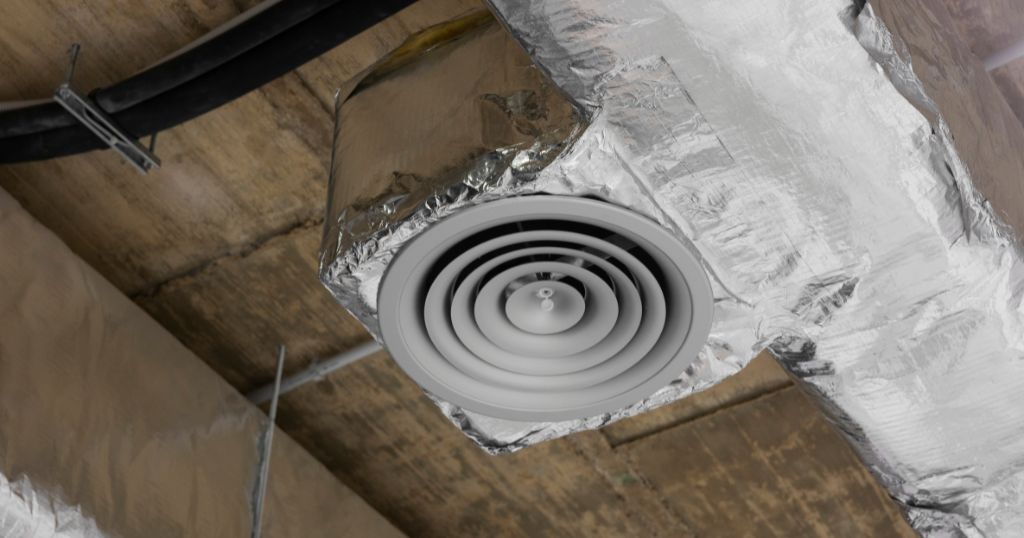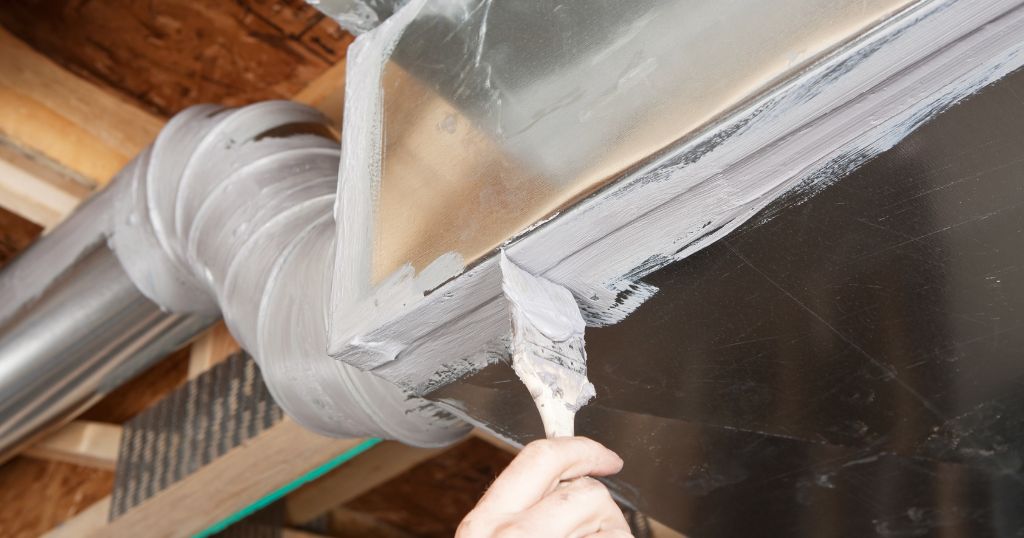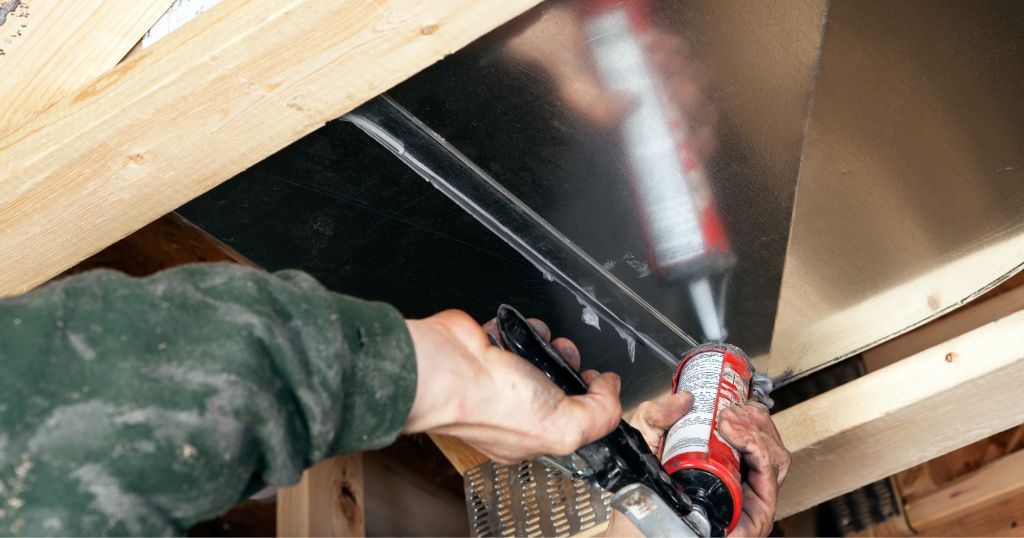All filters are made in the USA – Order Today

Imagine feeling a cool breeze in your living room while the upstairs bedroom stays toasty warm. Crazy, right? But leaky air ducts can turn that nightmare into a frustrating reality.
Think of your air ducts as the hidden highways for your home’s comfort. Over time, these pathways can develop tiny cracks and gaps, letting precious conditioned air escape. That means your air conditioner and heater work overtime, your energy bills skyrocket, and you’re left feeling hot and bothered (or cold and miserable, depending on the season).
But there’s good news! Air duct sealing can patch up those leaks and bring your home’s comfort back to life. In this blog, we’ll break down the magic behind air duct sealing, from the “why” to the “how,” and explore the amazing benefits it brings. So, buckle up, grab your favorite reading blanket (pun intended!), and dive into the world of efficient, comfortable living!

Suppose your house is a living, breathing organism (okay, maybe not literally, but stay with me!). Just like we need lungs to pump air throughout our bodies, your home relies on air ducts to deliver cool air in the summer and toasty warmth in the winter. These hidden heroes operate silently behind the scenes, ensuring your comfort no matter the season.
But what exactly are these mysterious air ducts, and how do they work their magic?
Air ducts are a network of tubes and channels installed throughout your home, typically within walls, ceilings, and floors. They connect your central heating, ventilation, and air conditioning (HVAC) system to the various rooms. Imagine them as the circulatory system of your home, carrying the breath of comfort wherever it’s needed.
Here’s a simplified breakdown of their journey:
It’s a continuous loop, ensuring your home maintains a comfortable temperature and air quality. But just like our own lungs need occasional care, air ducts can become leaky or clogged over time, impacting their efficiency. That’s where air duct sealing comes in, but we’ll explore that in the next section!
So, your air ducts are working hard to keep you comfortable. But even the most dedicated workers need a tune-up sometimes. That’s where air duct sealing comes in. Imagine a leaky hose. Water sprays everywhere, right? It doesn’t reach its intended destination efficiently, and you waste a precious resource. The same happens with leaky air ducts. Tiny cracks and gaps let the precious conditioned air escape, creating a whole host of problems, including:
Sealing those leaks is like patching up a leaky hose. You regain efficiency, save money, and improve your home’s comfort and health. You can consider it as an investment in your well-being and your wallet!

Now that you understand the importance of air duct sealing, it’s time to learn about how this “airtight” magic happens. There are two main approaches: traditional methods and advanced technologies.
No matter the method, air duct sealing involves these key steps:
Remember, sealing your air ducts is an investment, not just an expense. It can save you money on energy bills, improve your comfort and indoor air quality, and extend the life of your HVAC system. You will learn about all the other benefits of air duct sealing in the next section of this blog.

Sealing your air ducts is more than just plugging holes; it unlocks a wealth of benefits for your home and your health. Here is the list of benefits that you may get with air duct sealing:
Imagine coming home from a long day craving fresh, clean air. Instead, you’re met with dust, allergens, and even pollutants circulating through leaky ducts. Not ideal, right? Sealing the leaks acts as a giant air filter, trapping dust, debris, and harmful particles before they enter your lungs. This is especially useful for allergy sufferers and those with respiratory issues.
Your energy bills are a monster you battle every month. Leaky ducts fuel that monster, forcing your HVAC system to work overtime to compensate for lost air. Sealing those leaks weakens the monster, leading to significant energy savings. Studies show that proper sealing can reduce your energy bills by up to 20%! That’s money you can put towards other things, like that dream vacation or a relaxing spa day.
Ever feel like your living room is a sauna and your bedroom is an icebox? Leaky ducts disrupt the flow of conditioned air, resulting in uneven temperature throughout your home. Sealing them ensures consistent air distribution, allowing you to achieve the Goldilocks-like “just right” temperature in each room. Stop shivering in the summer and sweating in the winter!
Your HVAC system works nonstop to keep you comfortable. However, leaky ducts put unnecessary strain on it, causing wear and tear and potentially shortening its life. Sealing those leaks is similar to giving your HVAC a well-deserved massage, which reduces stress and extends its life. This means fewer repairs and replacements, which saves you money and hassle in the long run.
You not only save money by using less energy because of sealed ducts, but you also help the environment. Reduced energy consumption results in fewer greenhouse gas emissions, which contributes to a cleaner planet for all. So sealing your ducts benefits both you and the environment!

So you’re convinced of the benefits of air duct sealing, but now it’s time to decide whether to do it yourself or hire a professional for this task. Both options have their advantages and disadvantages. Let’s dive deep to learn the pros and cons of both:
Pros of DIY Sealing:
Cons of DIY Sealing:
Pros of Professional Sealing:
Cons of Professional Sealing:
Ultimately, the choice depends on your comfort level, budget, and the complexity of your ductwork.
Here’s a handy guide:
Remember, investing in professional sealing can save you money in the long run by increasing energy efficiency and reducing HVAC strain. Consider it an investment in your home’s comfort, health, and finances!
While air duct sealing can provide numerous benefits, it is not always necessary. How do you know if your home’s air ducts need some TLC? Here are some important signs to look out for:
If you notice any of these signs, you should have your air ducts inspected by a qualified professional. They can evaluate the condition of your ducts and recommend the best way to seal leaks.
Air duct sealing can provide numerous benefits to homeowners, including increased energy efficiency, reduced HVAC strain, and improved indoor air quality. While some homeowners may choose to tackle the project themselves, it’s important to consider your DIY skills, budget, and ductwork complexity before making a decision.
Hiring professionals can provide added convenience, peace of mind, and value through warranties and guarantees. By addressing signs of leaky ducts, such as uneven temperatures, high energy bills, increased dust and allergies, visible dust buildup, and strange sounds, homeowners can improve their home’s comfort, health, and finances.
Ultimately, air duct sealing should be viewed as an investment in your home’s long-term well-being. In addition to air duct sealing, you can consider replacing your HVAC air filters to enhance the efficiency of your equipment and improve your indoor air quality.
If you are searching for quality HVAC air filters, Custom Filters Direct offers high-quality HVAC filters to its valued clients. Call us today at 1-877-958-5612 for more details!
Yes, duct sealing can be an effective way to improve your home’s comfort and energy efficiency, and indoor air quality. Studies have shown that leaky ducts can waste up to 20% of your heating and cooling energy, and sealing them can significantly reduce your energy bills. Additionally, leaky ducts can allow dust, allergens, and pollutants to enter your home, which can worsen allergies and respiratory problems.
Sealing your ducts can help improve your indoor air quality and make your home more comfortable. However, the effectiveness of duct sealing depends on several factors, such as the severity of the leaks, the type of sealant used, and the quality of the work. It’s important to hire a qualified professional to inspect your ducts and recommend the best course of action.
Aerosol duct sealing works like tiny robots patching up leaks from within. Imagine a mist of atomized sealant particles injected into your ducts. These particles travel through the entire system, seeking out and sticking to any leaks they find. Like microscopic glue, they build up, sealing the leaks and preventing air from escaping. This minimally invasive method avoids the mess and disruption of traditional methods, reaching even hidden leaks for a more comprehensive seal.
For optimal duct sealing, consider your situation. If leaks are easily accessible and you’re handy, traditional methods like mastic or caulk might be suitable. However, for complex systems or hidden leaks, professional aerosol sealing offers comprehensive reach with minimal disruption. Seek certified professionals, compare quotes, and consider warranties. Remember, while the initial cost might seem high, weigh it against long-term energy savings and improved comfort. Choose the method that effectively seals your leaks and fits your budget and needs.
Leaky ducts? Not everyone needs an air duct sealing service! Here’s how to know if it’s right for you. Air duct sealing is required in these situations:
Have any questions? We’re here and ready to help!
© 2022 Custom Filters Direct. All rights reserved.